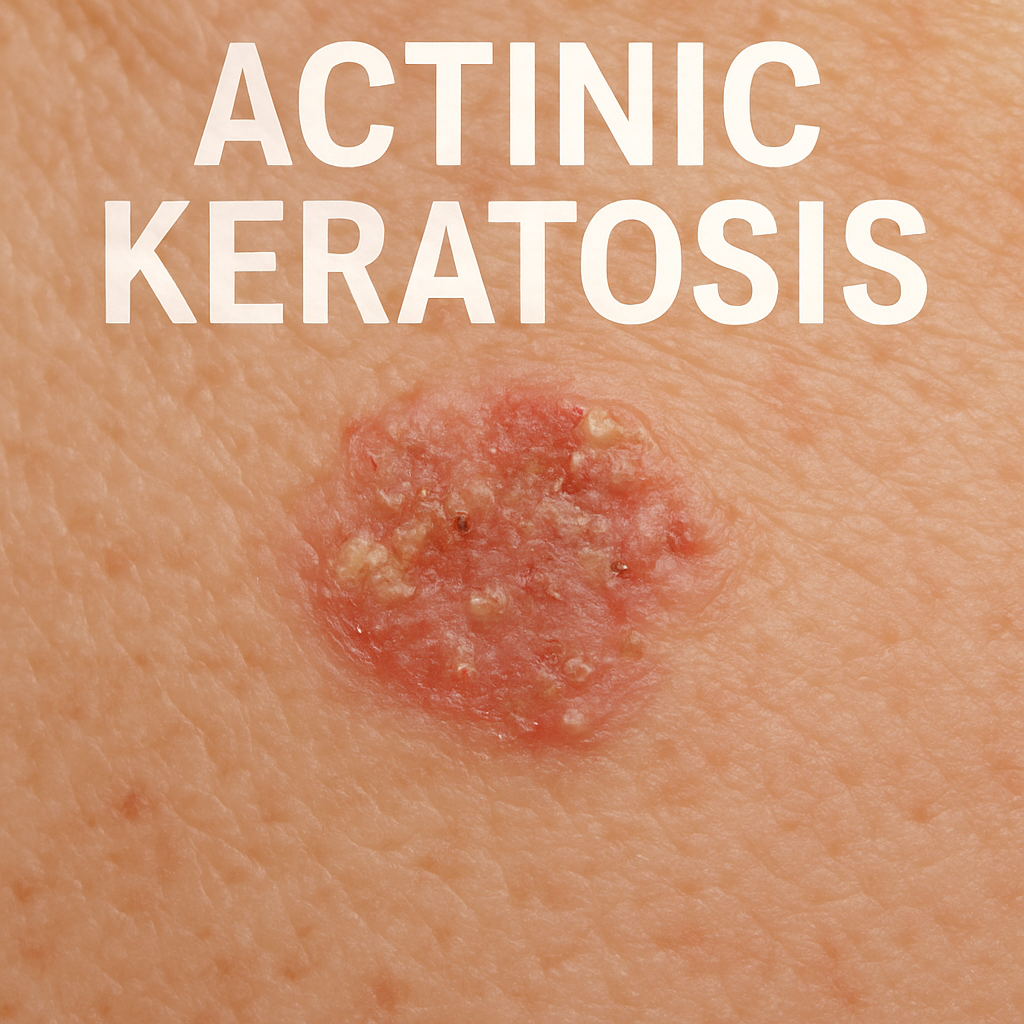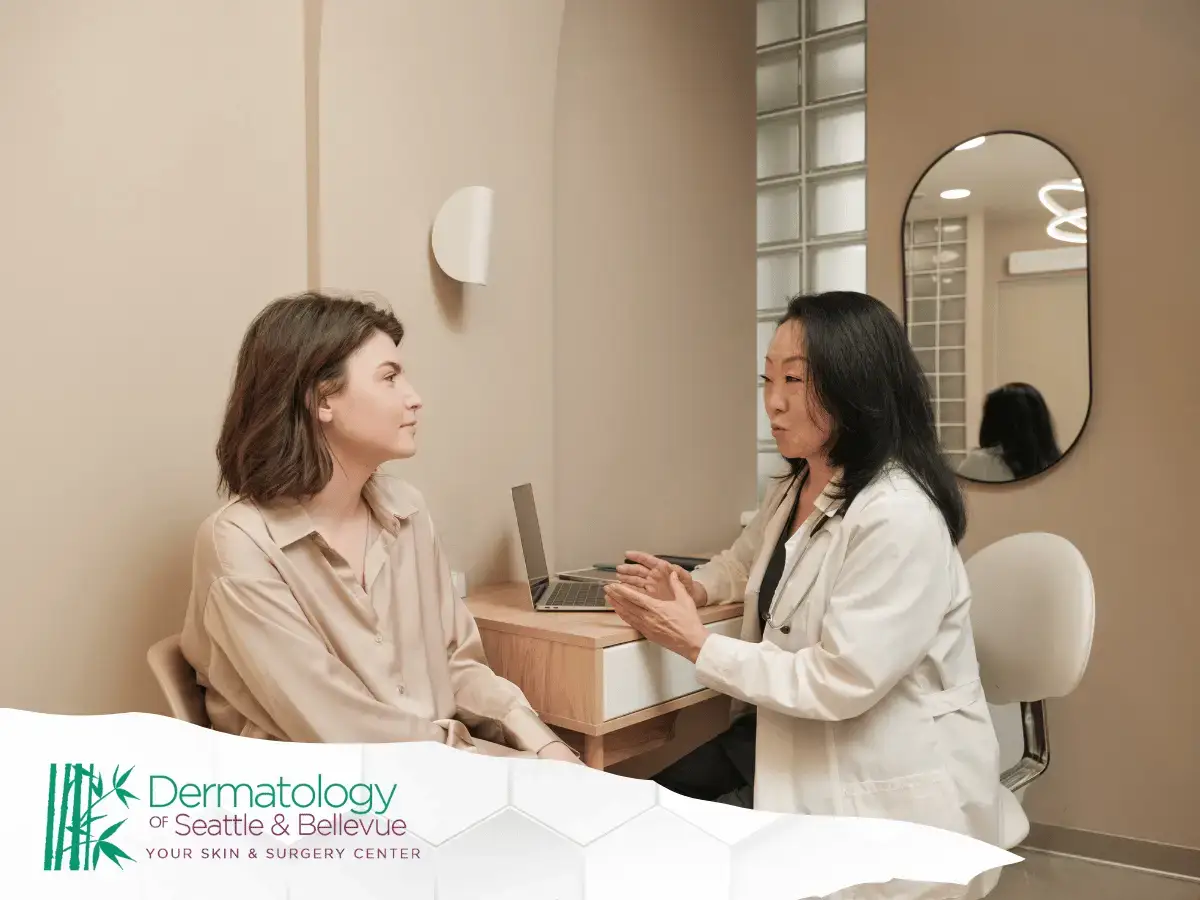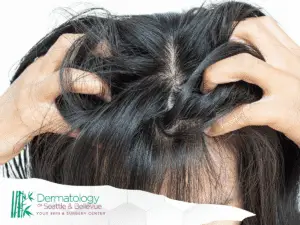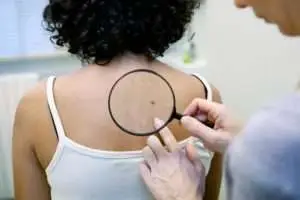Actinic keratoses are rough, scaly patches caused by years of UV exposure. They’re considered precancerous skin lesions, meaning they can develop into squamous cell carcinoma if left untreated. Early identification and treatment, such as cryotherapy, topical medications, or photodynamic therapy, are key for skin cancer prevention. These lesions appear most often on sun-exposed areas like the face, scalp, lips, and hands, especially in people with fair skin or significant sun damage. Understanding symptoms of actinic keratosis helps you catch them early and take the right steps to protect your long-term skin health. Dermatology of Seattle specializes in early detection, diagnosis, and safe removal to reduce your risk.

Actinic keratoses, also called solar keratoses, appear as rough, sandpaper-like spots in areas that get the most sun exposure. They can be flat or raised, red, pink, brown, or skin-colored. Because these lesions develop slowly over years, early detection gives you the best chance to prevent progression. The face, scalp, ears, neck, lips, and hands are the most common locations, especially in individuals who’ve accumulated decades of sun exposure.
Causes of Actinic Keratoses
Long-term ultraviolet (UV) exposure, from the sun or tanning beds, is the main cause. UV rays damage skin cells over time, leading to abnormal growth and precancerous skin lesions.
The core driver behind actinic keratoses is cumulative sun damage. UV radiation harms skin cell DNA, and over many years this damage can create abnormal cell growth. This is why actinic keratoses are far more common in older adults and in people with a history of significant outdoor exposure.
People with fair skin, light eyes, or light hair have lower melanin levels, meaning less natural protection from UV rays. These individuals burn more easily and accumulate sun damage skin over time, increasing the likelihood of developing actinic keratoses.
Risk Factors
Age, fair skin, high UV exposure, outdoor lifestyles, and weakened immune systems increase the risk of actinic keratoses.
Several factors can increase the likelihood of developing actinic keratoses:
- Age: Years of accumulated UV exposure make actinic keratoses more common in older adults. As the skin ages, its natural ability to repair DNA damage declines, increasing vulnerability to abnormal growth.
- Skin Type: People with fair skin or red/blonde hair burn more easily and have less melanin, which reduces natural UV protection. Repeated burning accelerates DNA damage and raises the risk of symptoms of actinic keratosis.
- Geographic Location: Living in sunny regions, high altitudes, or near the equator increases UV intensity. These environments expose the skin to stronger rays for longer periods, making actinic keratoses more likely.
- Outdoor Activities: Frequent outdoor time, gardening, hiking, sports, without protection leads to cumulative UV exposure. Even mild, repeated sun damage adds up over the years.
- Weakened Immune System: People with immune suppression, from medications, autoimmune conditions, or illnesses like HIV, are more susceptible because their bodies cannot repair UV-damaged skin cells as effectively.
Recognizing Early Signs
Actinic keratoses often feel like rough, sandpaper-like patches and may appear red, pink, or brown. Early recognition prevents progression into squamous cell carcinoma.

Signs to watch for include:
- Rough, dry, or scaly patches that feel like sandpaper
- Flat or slightly raised lesions that may be detected by touch
- Color changes such as red, pink, or brown spots
- Itching, burning, or tenderness in the affected area
These lesions may appear alone or in clusters, especially in areas with long-term sun exposure. If you notice changes in texture, color, or sensitivity, scheduling an evaluation with a dermatologist is essential for early skin cancer prevention.
Treatment Options
Actinic keratoses can be treated with cryotherapy, topical medications, or advanced options like photodynamic therapy. The goal is to remove lesions before they progress into skin cancer.
Treatment aims to eliminate abnormal cells while preventing progression into squamous cell carcinoma. Your dermatologist will recommend an option based on the number of lesions, their size, and your overall skin health.
Cryotherapy for Actinic Keratosis
Cryotherapy is one of the most common first-line treatments. Liquid nitrogen is applied to freeze the lesion, causing it to blister and eventually peel off. It’s quick, highly effective for isolated spots, and requires little downtime.
Temporary redness, swelling, or mild scarring can occur. Cryotherapy is ideal for patients with small, well-defined lesions and is widely offered in dermatology clinics.
Topical Treatments
Topical therapies are helpful for patients with multiple actinic keratoses or widespread sun damage skin. These medicated creams stimulate the immune system or directly target abnormal cells.
Common options include:
- 5-Fluorouracil (5-FU): A topical chemotherapy cream that destroys precancerous cells.
- Imiquimod: Boosts the immune response to target abnormal cell growth.
- Diclofenac: An anti-inflammatory gel that slows and disrupts abnormal cell development.
- Ingenol mebutate: Induces rapid cell death and works well for both small and large areas.
These treatments often cause redness, peeling, crusting, and temporary discomfort as the skin clears damaged cells. Patients should be prepared for the skin to look worse before it heals, this is a normal part of the treatment process.
Photodynamic Therapy (PDT)
Photodynamic therapy is a two-step treatment used for widespread or stubborn actinic keratoses. A light-sensitive solution is applied to the skin, then activated with a specialized light source. This process selectively destroys abnormal cells while sparing healthy tissue. PDT is ideal for patients with multiple lesions or significant sun damage across larger areas.

The treatment is minimally invasive, well-tolerated, and can be repeated as needed. It often results in smoother, healthier skin and is especially effective for facial and scalp lesions. Temporary redness or sensitivity after treatment is normal.
Curettage and Electrosurgery
Curettage and electrosurgery involve first scraping away the visible lesion with a curette, then using an electrical current to eliminate any remaining abnormal cells. This method is typically reserved for thicker, more resistant actinic keratoses.
The procedure is efficient and performed in-office, but it may result in temporary changes in pigmentation or mild scarring. Despite these considerations, it remains a reliable option for lesions that don’t respond to more conservative treatments.
Prevention Tips
Daily sun protection, avoiding tanning beds, and regular skin checks are the most effective ways to prevent actinic keratoses and reduce future signs of skin cancer risk.
Preventing actinic keratoses starts with consistent, long-term UV protection. These simple habits significantly reduce cumulative UV damage and lower the chance of developing precancerous skin lesions.
- Use Sunscreen: Apply broad-spectrum SPF 30 or higher every day, even on cloudy days. Reapply every two hours, and more often if swimming or sweating. Sunscreen is one of the most effective tools for lifelong skin cancer prevention.
- Wear Protective Clothing: Long sleeves, wide-brimmed hats, sunglasses, and UV-protective clothing help guard vulnerable areas like the face, scalp, and hands.
- Seek Shade: Limit direct sun exposure between 10 a.m. and 4 p.m., when UV rays are strongest. Use umbrellas or shaded areas when outdoors for extended periods.
- Avoid Tanning Beds: Tanning beds emit harmful UV radiation similar to the sun and significantly increase skin cancer risk. Choose sunless tanning products instead.
- Regular Skin Checks: Perform monthly self-exams and schedule dermatology visits for routine screenings. Catching symptoms of actinic keratosis early is vital for preventing progression.
When to See a Dermatologist
Schedule an exam if you notice new spots, rough patches that persist, or lesions that change in color, texture, or sensitivity.
If you have risk factors such as fair skin, extensive sun exposure, a history of sunburns, or a weakened immune system, routine dermatologist visits are especially important. Early evaluation ensures prompt, effective treatment, whether that’s cryotherapy, topicals, PDT, or additional interventions tailored to your skin.
Conclusion
Early recognition, sun protection, and timely treatment are key to preventing actinic keratoses from progressing into skin cancer.
Understanding the actinic keratosis causes, early warning signs, and available treatments empowers you to protect your skin long-term. With consistent sun protection, routine skin checks, and guidance from a dermatologist, you can significantly reduce your risk and maintain healthier skin over time.
Being proactive, especially if you live in sunnier climates, spend time outdoors, or have a history of sun damage, makes a meaningful difference in preventing future lesions and preserving overall skin health.
If you’ve noticed rough, scaly patches or changes in sun-exposed skin, early evaluation makes all the difference. Our dermatologists at Dermatology of Seattle, with locations in Seattle, Bellevue, and Burien, specialize in the diagnosis and treatment of actinic keratoses and other sun-related conditions.
Schedule a skin check to get personalized care and protect your long-term skin health.





